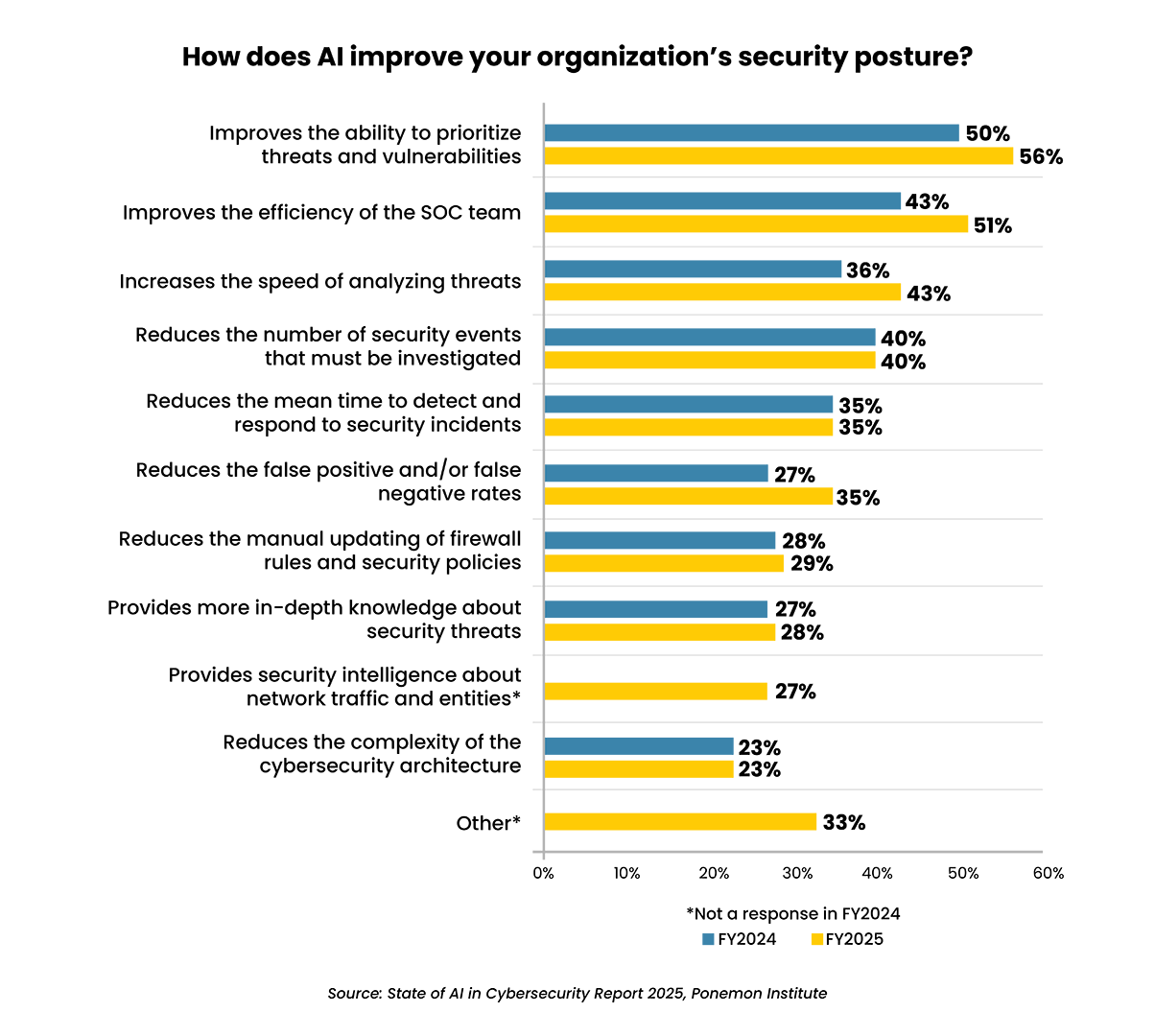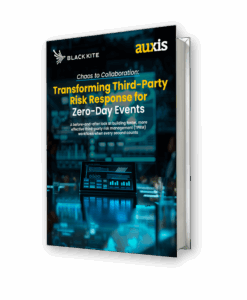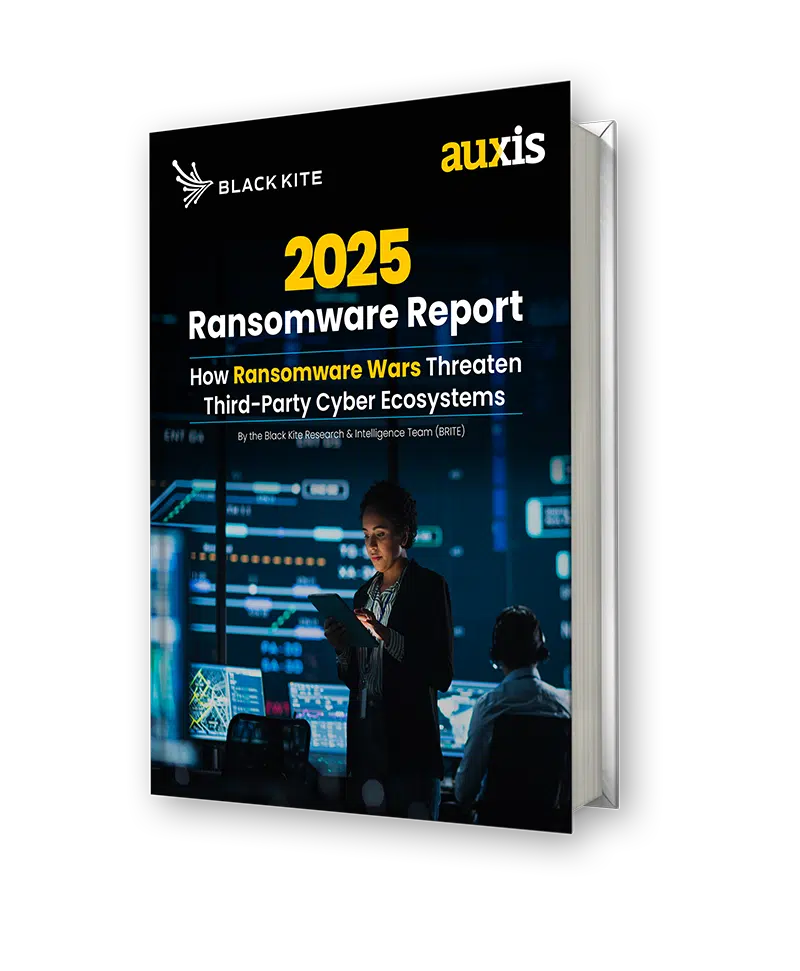In brief:
- AI is redefining cybersecurity – empowering both attackers and defenders with greater speed, scale, and sophistication.
- While 96% of professionals say detecting AI-powered threats is critical, only 26% feel confident in their ability to do so.
- Key AI-driven cybersecurity trends include predictive threat intelligence, automated incident response, advanced phishing detection, and behavior-based threat analysis.
- Agentic AI and Generative AI in cybersecurity bring challenges, from adversarial AI to ethical concerns, that require strong governance, transparency, and ethical oversight to ensure AI enhances security without compromising trust.
AI isn’t just changing cybersecurity – it’s redefining it. From powering faster, more sophisticated attacks to exposing gaps in legacy defenses, AI is forcing a fundamental shift in how we protect our organizations. Staying ahead requires a clear understanding of emerging AI-driven threats – and the latest tools and trends on AI security designed to combat them.
The statistics are sobering: 93% of security leaders anticipate their organizations will face daily AI attacks this year (Netacea 2024 Cyber Security in the Age of Offensive AI report).
And it’s not just the volume of attacks that’s accelerating. AI has slashed breakout times (how long it takes attackers to move laterally across systems) to under an hour, primarily driven by AI-generated phishing, deepfakes, and adaptive malware (2025 McKinsey report: AI is the Greatest Threat – and Defense – in Cybersecurity Today).
AI’s impact on cybersecurity is no longer a future concern – it’s a present-day crisis. Yet despite the growing urgency to manage and prevent these threats, cybersecurity readiness levels have largely stagnated in the past year (Cisco Cybersecuity Readiness Index 2025).
To stay resilient, organizations must rethink their approach to cybersecurity – starting with a firm grasp of the latest trends in AI security and an effective strategy to integrate them into their defenses.
How AI is changing cybersecurity
The relationship between AI and cybersecurity is one of the most complex dynamics in today’s digital landscape. Nearly 70% of IT leaders are incorporating AI as part of their cybersecurity strategy (IBM’S Cost of a Data Breach report 2024). Companies that leverage it extensively for proactive prevention experience 46% lower costs from a data breach than those that do not – a difference of more than $2.2 million.
At the same time, we’re witnessing an alarming rise in AI-powered attacks. An estimated 40% of cyberattacks are now AI-driven events that evade traditional detection methods. Case in point: Generative AI tools and automation are helping hackers compose phishing emails up to 40% faster – and prompting 78% of recipients to open them (SoSafe Awareness report).

This creates an ongoing arms race where defenders must continuously innovate to stay ahead of increasingly sophisticated adversaries.
Making matters worse, two key trends are today causing attack surfaces to grow, creating more entry points for AI-fueled threats:
- Rapid technology adoption: The shift to cloud, mobile, IoT, and remote work tools has added countless new endpoints. More than 80% of organizations have been targeted through personal devices or accounts (SoSafe Cybercrime Trends 2025 Report).
- Increased third-party exposure: Modern businesses rely on vast, interconnected supply chains and every vendor – and even their vendors – becomes part of your security perimeter. Nearly 60% of businesses have experienced a data breach due to third-party risk.
Traditional perimeter-based defenses are struggling to keep up with this new reality. Legacy security approaches that rely on static rules and manual processes simply cannot match the speed, scale, and sophistication of AI-enhanced threats.
This gap has created a critical need for intelligent, adaptive security automation solutions that can respond in real time to evolving attack patterns.
AI cybersecurity trends 2025: What IT leaders need to know
Let’s examine the key AI-driven cybersecurity trends that can help strengthen your security posture in 2025:
1. AI-powered threat detection for speed and accuracy
Modern AI algorithms are revolutionizing threat detection by identifying anomalies and patterns indicative of cyberattacks with unprecedented accuracy and speed. These systems can process vast amounts of security data in real time, spotting subtle indicators that would be impossible for human analysts to detect manually.
70% of security professionals believe AI has proved highly effective for detecting threats that previously would have gone unnoticed.
Source: 2025 Ponemon Institute Report
Other top benefits include real-time responses that reduce the time taken to detect an attacker’s presence from weeks to minutes, a significant reduction in false positives, and intelligent threat triage and prioritization that ensures critical alerts are not missed.
Key use cases include:
- Network anomalies
Anomaly detection systems leveraging AI for network security and monitoring continuously analyze traffic to identify deviations from normal behavior – such as sudden spikes in latency, unusual packet flows, or abnormal user activity – that could indicate a DDoS (Distributed Denial of Service) attack or failing router. AI provides insights in real time that traditional threshold-based monitoring tools often miss. - Zero-day attacks
AI systems can identify previously unknown threats, known as zero-day attacks, by analyzing behavioral patterns rather than relying on signature-based detection. - Insider threats
Machine learning models can establish baseline user behaviors and flag anomalies that may indicate compromised accounts or malicious insider activity. - Advanced phishing detection
AI can analyze email content, sender patterns, and contextual clues to identify sophisticated phishing attempts that bypass traditional filters.
2. Automated security incident response for containing security breaches
AI-driven security operations automation is enhancing incident response by empowering organizations to react to security breaches with greater speed and consistency. By autonomously executing response playbooks – such as isolating compromised devices, blocking malicious IP addresses, and triggering recovery protocols – AI significantly reduces the need for manual intervention during critical moments.
Organizations using AI and automation in their cybersecurity efforts cut breach lifecycles by 108 days and save an average of $1.76 million per incident compared to those that don’t.
IBM Cost of a Data Breach Report 2024
3. AI-powered phishing detection to block sophisticated email attacks
Large Language Models (LLMs) and advanced AI systems are overhauling email security, proactively detecting and blocking a new wave of sophisticated phishing attacks. More than 40% of business email compromise messages are now AI-generated – crafted with polished grammar, personalized content, and a level of realism that easily bypasses traditional rule-based filters. (VIPRE 2024 The New Face of Fraud Report).
Enter AI-powered phishing detection. Gartner highlights AI-driven email security as a key trend for reducing phishing exposure in 2025, with independent evaluations showing state-of-the-art AI phishing detection models can achieve up to 97.5% accuracy in identifying malicious emails.
These systems analyze linguistic patterns, sender reputation, and contextual clues to flag threats – even when messages appear legitimate to human recipients.
4. Intelligent vulnerability management for better prioritization
Artificial intelligence is improving vulnerability management by enabling smarter prioritization and faster remediation. Rather than simply ranking vulnerabilities by severity scores, AI systems can prioritize based on actual exploitation likelihood, environmental context, and business impact.
This intelligent approach addresses a critical challenge: with over 45,000 new vulnerabilities predicted for 2025 by the non-profit Forum of Incident Response and Security Teams, organizations must focus their limited resources on the threats that pose the greatest real-world risk.
AI-enhanced vulnerability management systems can automatically correlate threat intelligence with an organization’s specific infrastructure, identifying which vulnerabilities are most likely to be exploited and providing contextual remediation guidance.
5. Predictive threat intelligence for proactive defense
Besides threat detection, AI’s predictive capabilities are enabling organizations to anticipate threats even before they materialize. By analyzing historical attack patterns, current threat intelligence, and environmental factors, AI systems can forecast potential attack vectors and recommend proactive defensive measures.
This capability is particularly valuable when integrated with Security Information and Event Management (SIEM) tools, creating a comprehensive threat intelligence ecosystem.
For example, zero-day attacks are notoriously difficult to defend against because they exploit previously unknown vulnerabilities – giving attackers a critical head start. Generative AI in cybersecurity is changing the game.
By analyzing patterns, simulating realistic attack scenarios, and detecting subtle anomalies, AI can help identify indicators of zero-day threats before they’re officially recognized. As AI-powered predictive threat intelligence evolves, it empowers organizations to shift from a reactive stance to a proactive, preemptive defense – helping to anticipate and neutralize threats before damage is done.
6. Behavioral analysis for stronger endpoint protection
AI is upgrading Endpoint Detection and Response (EDR) by shifting the focus from traditional signature-based detection to advanced behavioral analysis. While signature-based tools can only identify threats that match known patterns – requiring prior knowledge of the attack – AI-powered EDR analyzes behavior in real time to detect anomalies, uncovering previously unseen threats like zero-day exploits, novel malware variants, and fileless attacks.
Today’s threat actors move quickly and creatively, often bypassing signature-based defenses with new or modified attack methods. By recognizing suspicious behaviors rather than relying on known signatures, AI-enhanced EDR enables faster, smarter threat detection – giving organizations a crucial edge in preventing breaches before damage occurs.
7. Machine learning to fight back against intelligent malware strains
Today’s malware is smarter, faster, and more evasive than ever. Machine learning (ML) algorithms are fighting back: analyzing and classifying new malware strains capable of mutating or changing their code to evade detection.
Unlike static, signature-based methods, these ML algorithms evaluate malware based on behavioral patterns and intrinsic characteristics – allowing for faster, more accurate identification of previously unseen threats. AI-powered malware analysis can process and classify up to 10,000 samples per hour, according to IBM’s 2025 Threat Intelligence Index – a workload that would take human analysts weeks to complete.
The speed and scalability enabled by this cybersecurity automation are essential for staying ahead of emerging threats and dramatically reducing the window of vulnerability for cyberattacks.
8. AI to strengthen cloud security
Cloud attacks are on the rise amid widespread adoption and frequent misconfigurations that make them an easy entry point for attackers, with 80% of organizations reporting an increase in attacks (SentinelOne 2025 Cloud Security Statistics Report). Unfortunately, that’s exposing critical business data, disrupting operations, and escalating financial and reputational risks.
AI systems play a critical role in strengthening cloud security by continuously monitoring traffic patterns across platforms, identifying misconfigurations, and enforcing consistent security policies regardless of the underlying infrastructure. This last capability is especially critical for implementing Zero Trust architectures, which require verification of every access request, regardless of location or network.
AI-enhanced cloud security solutions can also detect unusual data access patterns, unauthorized privilege escalations, and other subtle indicators of compromise that might indicate a breach is in progress.
9. The emergence of Agentic AI in cybersecurity
While implementation remains in the early stage, Agentic AI is poised for broader adoption in cybersecurity efforts. While 0% of security leaders have fully deployed Agentic AI, 59% said they are actively working on it – with real-world use cases already driving improved detection, response times, and Security Operations Center (SOC) efficiency, according to the 2025 Cyber Security Tribe Annual Report.
Industry platforms like Microsoft Security Copilot and CrowdStrike Charlotte AI are also already embedding Agentic AI cybersecurity strategies for faster response times, lower analyst workload, and better threat coverage.
Agentic AI takes cybersecurity automation to the next level with intelligent agents that can orchestrate and automate judgment-heavy, end-to-end processes that were previously beyond the reach of automation, with minimal human input. Key benefits include:
- Monitoring threats in real time and making context-aware decisions without constant human intervention
- Orchestrating responses across systems (for example, isolating endpoints, revoking access, resetting credentials) in a coordinated, end-to-end fashion
- Learning from incidents using feedback loops and machine learning to continuously improve detection and response strategies
- Reducing alert fatigue by triaging and resolving lower-risk threats autonomously, allowing human analysts to focus on high-priority incidents
By combining the power of Generative AI, RPA, LLMs, and API-based coordination, agentic automation can build cyberdefense systems that are not only faster, but also more resilient, scalable, and proactive than traditional approaches.

Challenges and ethical considerations
While AI-aided cybersecurity is providing organizations with the means to build a better defense against escalating attacks, it also brings some challenges and ethical issues to consider.
1. The rise of adversarial AI
The rise of AI in cybersecurity is giving way to a new class of threats: adversarial AI. As cybercriminals develop AI specifically designed to outsmart AI-powered defenses, organizations face a fast-evolving arms race. In adversarial AI, two neural networks compete to outmaneuver each other – fueling rapid advancements in both attack methods and defensive countermeasures.
Nearly 47% of organizations now rank adversarial Generative AI deployments as their most pressing concern, according to the World Economic Forum’s (WEF) Global Cybersecurity Outlook 2025. Why? Because it’s enabling more scalable and sophisticated attacks – from deepfakes and data poisoning to AI-generated phishing – that make traditional security strategies increasingly ineffective.
2. Over-reliance on cybersecurity automated systems
While AI delivers critical advantages, over-reliance on security automation can lead to blind spots and false confidence. While AI is powerful, it’s not infallible – and depending on it too heavily without proper human oversight can introduce risks. For example, AI lacks human intuition that can cause it to miss nuanced threats that require understanding of business processes or user intent.
Moreover, AI systems are vulnerable to adversarial tactics like data poisoning or manipulation, which can compromise their integrity. Yet despite these risks, only 37% of organizations have established processes to assess the security of their AI tools before deployment, according to the World Economic Forum report.
To truly benefit from AI, organizations must pair it with expert human oversight and robust evaluation protocols.
3. Questions about data privacy and AI bias
The deployment of AI in cybersecurity raises important questions about data privacy, algorithmic bias, and transparency in security decision-making. While AI can enhance threat detection and response, it can also unintentionally compromise user privacy or discriminate against specific groups due to biased training data.
The opaque, “black box” nature of many AI models makes it difficult to trace how decisions are made, creating challenges in identifying and correcting harmful biases or errors.
These risks aren’t hypothetical: In 2024 alone, there were 233 documented AI-related privacy and security incidents, a 56.4% increase from the previous year, according to the Stanford AI Index Report. As AI becomes more deeply embedded in security operations, establishing strong governance, transparency, and ethical oversight hold the key to addressing these risks.
4. Complexity created by stricter compliance requirements
Calls for regulations and government oversight around AI usage, sensitive data protection, and cybersecurity are creating additional complexity for organizations implementing AI-powered security solutions.
Laws like the EU AI Act mandate rigorous transparency, accountability, and risk management standards – backed by steep penalties of up to 7% of a company’s global annual revenue for non-compliance. In the U.S., the California AI Transparency Act requires providers to clearly disclose AI-generated content and enforce contractual safeguards, with fines of $5,000 per violation per day.
These evolving regulations are reshaping global compliance strategies, forcing businesses to rethink how they govern and implement AI trends in cybersecurity.
Why Auxis: Combining AI innovation with excellence in security operations
AI is transforming cybersecurity – but it’s also making attacks faster, smarter, and harder to detect. While 96% of professionals say detecting AI-powered cyberthreats is critical, only 26% feel confident in their ability to do so (SoSafe).
It’s no surprise that cybersecurity is now the most outsourced business function, as organizations increasingly rely on managed security services providers (MSSPs) to deliver the specialized talent, tools, and threat intelligence needed to stay ahead (Deloitte 2024 Global Outsourcing Survey).
Auxis brings together deep cybersecurity expertise and an award-winning AI and automation practice to help businesses identify and implement the solutions they need to modernize their defenses. Included among a select group of UiPath Platinum and Agentic Automation Fast Track Partners, Auxis brings a proven track record of helping organizations deploy AI securely and effectively – strengthening governance, protecting data, and minimizing risk.
With proprietary AI-powered tools, best-in-class technology partnerships, and a nearshore delivery model that reduces costs without compromising quality, Auxis enables smarter, more resilient cybersecurity – without the heavy lift.
Ready to strengthen your organization’s cybersecurity capabilities? Schedule a consultation with our cybersecurity experts today! You can also visit our resource center for more IT security tips, strategies, and success stories.
Frequently Asked Questions
Explain how AI is changing cybersecurity.
How can Generative AI be used in cybersecurity?
What is cybersecurity automation and what repetitive security tasks can be automated with AI?
How is Agentic AI being used in cybersecurity operations?
How is AI for network security and monitoring transforming protection?
What should I look for in an AI cybersecurity solution provider?




